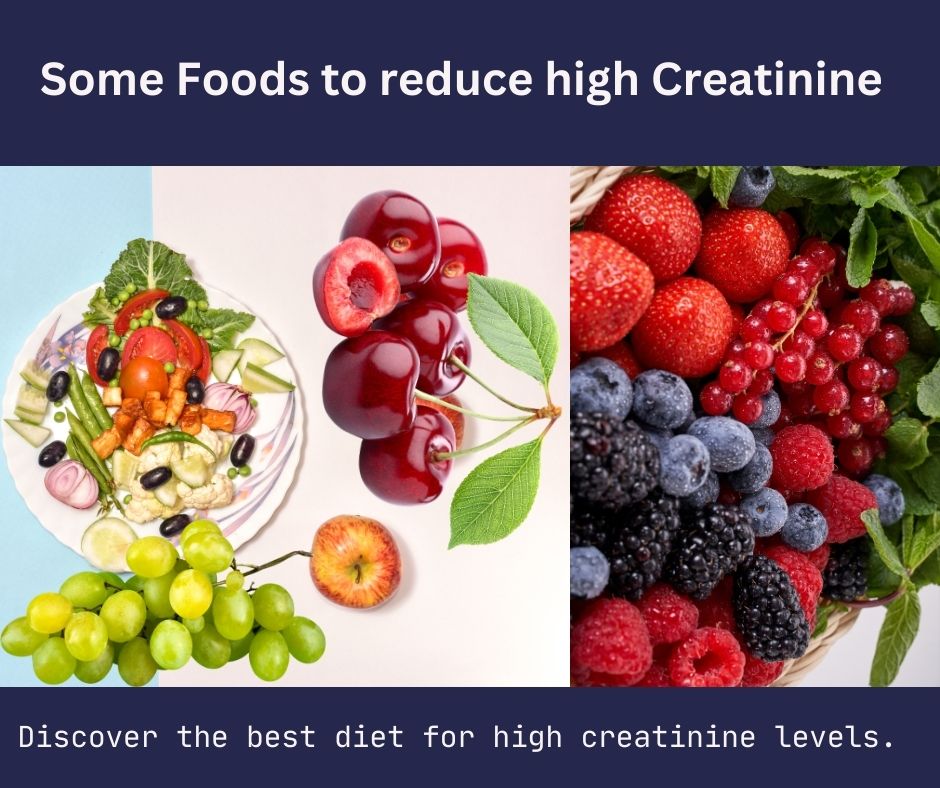
INDIAN DIET CHART FOR HIGH CREATININE PATIENT: FOODS TO INCLUDE AND AVOIDE
Table of Contents
- 1 INDIAN DIET CHART FOR HIGH CREATININE PATIENT: FOODS TO INCLUDE AND AVOIDE
- 1.1 CUSTOMISED INDIAN DIET CHART FOR HIGH CREATININE PATIENT
- 1.1.1 LIST OF INDIAN FOOD TO AVOID IN AN INDIAN DIET CHART FOR HIGH CREATININE PATIENT
- 1.1.1.1 What is creatinine, and why do we need to monitor creatinine levels?
- 1.1.1.2 2. What are the foods to be included in an Indian diet chart for reducing creatinine patient levels?
- 1.1.1.3 3. Can dairy be consumed in an Indian diet chart for reducing creatinine patient?
- 1.1.1.4 4. What are some of the specific Indian foods to be included in an Indian diet chart for high creatinine patient levels?
- 1.1.1.5 5. How much water should a person with high creatinine levels drink?
- 1.1.1 LIST OF INDIAN FOOD TO AVOID IN AN INDIAN DIET CHART FOR HIGH CREATININE PATIENT
WHAT IS CREATININE?
Creatinine is a chemical by-product of muscle metabolism. It is generated from creatine, a chemical found in the body naturally. After creatinine production, it is sent to the kidneys, the excretory organ, via blood circulation. Creatinine is produced from the body’s metabolism in the muscles from the chemical creatine. It is not useful for the body and is considered a waste product, which gets filtered out by the kidneys via urine.
WHY IS CREATININE HARMFUL?
Creatinine is a metabolic waste produced in the kidneys, so it should not be accumulated in the system. High creatinine levels are not associated with any health benefits; rather, they indicate deteriorating health issues, particularly potential kidney malfunctioning or disease.
INDIAN FOODS TO REDUCE CREATININE LEVELS
A healthy and specialised Indian diet chart for high creatinine patient is extremely important for maintaining high creatinine levels and is known to supplement the effectiveness of medicines. The foods consumed to manage high creatinine levels should only be curated by educated, board-certified nutritionists.
- The food part of the Indian diet chart for high creatinine patient levels should reduce the stress on kidney functioning. As creatinine is produced in kidneys as a metabolic waste, foods that help kidney functioning would indirectly help maintain high creatinine levels, as well.
- The food consumed in the Indian diet chart to reduce creatinine levels should be based on the patient’s medical history, weight, height, and any allergies. The patient should not feel hungry, which could lead to unregulated overeating, which would cause more harm than good.
- The Indian food chart for reducing creatinine levels should contain all the necessary nutrients, such as vitamins and minerals. Especially, sodium, potassium, and phosphorous levels should be kept within the allowed range.
LIST OF INDIAN FOOD THAT HELPS IN REDUCING CREATININE LEVELS
VEGETABLES
- CAULIFLOWER: It is a very common vegetable in Indian households and is easily available in Indian markets. It is rich in nutrients like calcium, Iron, and phosphorous and has vitamins A, B, and C.
- CABBAGE: Cabbage is a leafy vegetable very common in the Indian market. It’s packed with vitamins A and B, which are great for healthy cell growth. It also has alkaline properties, which help maintain the blood pH, thus maintaining kidney functions.
- BELL PEPPERS: Red and yellow bell peppers are great sources of nutrition. Even though they are not the most affordable vegetables available, they are packed with vitamins A and C but low in calories. They help keep cholesterol in check.
- GARLIC:- Garlic has a natural product called allicin. It has been widely used as an ayurvedic medicine for decades. It’s beneficial for kidney-related issues and other health conditions. It supports overall kidney health and helps in balancing creatinine levels.
- ONION: Onions are a staple vegetable in an Indian household. They are filled with vitamins A, B6, C, and E and minerals like Iron. Onions are also rich in dietary fiber and folic acid, which play a huge role in lowering creatinine levels.

FRUITS
- BERRIES: Berries like strawberries, raspberries, blueberries, and cranberries are fruits rich in antioxidants that help manage high creatinine levels in the body. Therefore, berries should be included in an Indian diet chart for high creatinine patient levels.
- RASPBERRIES: Raspberries are packed with nutrients like Iron, manganese, thiamine, riboflavin, magnesium, copper, zinc, and even calcium, as well as vitamins like pantothenic acid and vitamin B6. Blueberries are rich in antioxidants to be consumed by patients with hypertension, diabetes, and even obesity. Cranberries are rich in antioxidant properties, which are great for preventing urinary tract infection (UTI) in women, yeast infections, hypertension, and even kidney functions.
- GRAPES: Grapes are known for their high vitamin and resveratrol (antioxidant) content. They have a low glycaemic index, which prevents any glucose spike in the blood and is beneficial for controlling high creatinine levels. Therefore, patients following an Indian diet chart should consume grapes to reduce creatinine levels.
- CHERRIES: Cherries are particularly known for reducing high creatinine levels in patients with malfunctioning kidneys. They could be a great addition to an Indian diet chart for high creatinine patient levels.

CUSTOMISED INDIAN DIET CHART FOR HIGH CREATININE PATIENT
High creatinine levels could indicate a deteriorating kidney, and they should not be ignored. A board-certified dietician should be made on board to lead a healthier lifestyle. Dt. Rukhsana Azhar, associated with DIET4UWELNNESS, could be consulted for a reliable consultation. Managing high creatinine levels through diet has shown efficient results when a specific Indian diet chart catering to the high creatinine is targeted. The Indian diet for reducing high creatinine levels in kidney patients, which is of concern, should support kidney function and reduce the stress on the kidney, thus preventing further deterioration.
Morning Breakfast
- Start the day with a glass of warm water and a teaspoon of lemon juice, which will help cleanse the gut and provide hydration.
- Then, for the breakfast, one could have either of these options mentioned below:
- Plain oats with milk (dairy/soy/almond milk) are a good choice, as are fruits like grapes, berries like strawberries or blueberries, grapes, and even seasonal fruits like chopped mango pieces.
- Vegetable upma with nuts and raw onions.
- Quinoa with ample sautéed vegetables.
- Khichdi with vegetables like carrots, tomatoes, potatoes, and other seasonal vegetables.
- Idli (2 pieces) with sambhar containing many vegetables and coconut chutney.
- A bowl of fruit salad with homemade curd/yogurt.
Lunch
- Brown rice (half a bowl) or 2 piece chapatti (raagi/ bajra/ whole wheat)
- Mixed Vegetables with vegetables like cauliflower, cabbage, radish, carrot, potatoes, bell pepper, and all other seasonal vegetables.
- Lentil Soup, or Dal, can also be supplemented with vegetables.
- Chicken Curry with very less oil and butter.(Limit amount)
- Grilled fish
- Paneer with other mixed vegetables. (Limit amount)
Evening Snacks
- A bowl of fruits along with nuts like almonds and cashews.
- A bowl of boiled vegetables with black pepper and seasoning.
- One plain dosa with sambhar and coconut chutney.
Dinner
- Brown rice or quinoa.
- mixed vegetables.
- Fish curry.
- Vegetable curry with less to negligible oil.
LIST OF INDIAN FOOD TO AVOID IN AN INDIAN DIET CHART FOR HIGH CREATININE PATIENT
Below are some of the food items to avoid in an Indian diet chart to reduce High creatinine levels.
- High protein food: High protein-rich foods like red meat, chicken, and fish are high-protein non-vegetarian options that should not be included in an Indian diet chart for high creatinine patient.
- Excessive salty food items: High salt is present in highly preserved food, and canned foods contain high amounts of salt. It is desirable not to include these foods in an Indian diet chart for reducing high creatinine level patients.
- High-potassium foods: Bananas, oranges, tomatoes, and avocados are some of the high-potassium foods. These fruits are easily available in the Indian market and should not be included in the Indian diet chart for high creatinine patient.
- High-phosphorous-rich food: Some of the high-phosphorous food items are nuts, seeds, and whole grains. Therefore, nuts and seeds like pumpkin seeds, almonds, and cashew nuts should not be included in the diet chart for reducing creatinine levels.
FREQUENTLY ASKED QUESTIONS
-
What is creatinine, and why do we need to monitor creatinine levels?
Creatinine is a metabolic by-product produced by the body naturally due to its regular metabolic activities. As it is toxic to humans, the kidneys break down creatinine and excrete it along with urine.
2. What are the foods to be included in an Indian diet chart for reducing creatinine patient levels?
DIET4UWELLNESS mentions some of the consumable food items to be included in an Indian diet chart for reducing creatinine patient. Some of the foods are berries,cauliflower,onions and bellpeppers etc.
3. Can dairy be consumed in an Indian diet chart for reducing creatinine patient?
Dairy products are rich in phosphorous and potassium, which, when consumed in excess, could be harmful to the body, especially for patients with low-functioning kidneys. Therefore, if dairy is consumed in an Indian diet chart to reduce creatinine patient levels, its amount should be strictly monitored by a qualified and reliable dietician like Dr. Rukhsana Azhar.
4. What are some of the specific Indian foods to be included in an Indian diet chart for high creatinine patient levels?
Some of the specific Indian foods that could be included in an Indian diet chart for high creatinine patient levels are as follows:
- Low-potassium food like cucumber and carrots.
- Fruits like all types of berries, grapes, and apples.
5. How much water should a person with high creatinine levels drink?
Patients with unusually high levels of creatinine should carefully monitor their water intake. Staying hydrated is extremely important to aid the kidney in flushing out the metabolic wastes produced by the body. However, excess water could also be harmful. A board-certified dietician like Dr. Rukhsana Azhar would determine the exact prescribed amount based on a variety of factors, such as weight, height, and past medical conditions of the patient and fitness level .

Hello My Name is Dt. Ruksana Azhar and I am a certified dietician and providing online & offline services for Weight Management, PCOS/PCOD Management, Diabetes Management , etc. I have 12+ years of experience in the Apollo Hospital Delhi , Max Super Specialty Hospital Delhi, Lilavati Hospital Mumbai and VLCC healthcare Mumbai. I loves to write healthcare and lifestyle related blog. My favorite part of being a doctor is the opportunity to directly improve the health and wellbeing of my patients and to develop professional and personal relationships with them.



